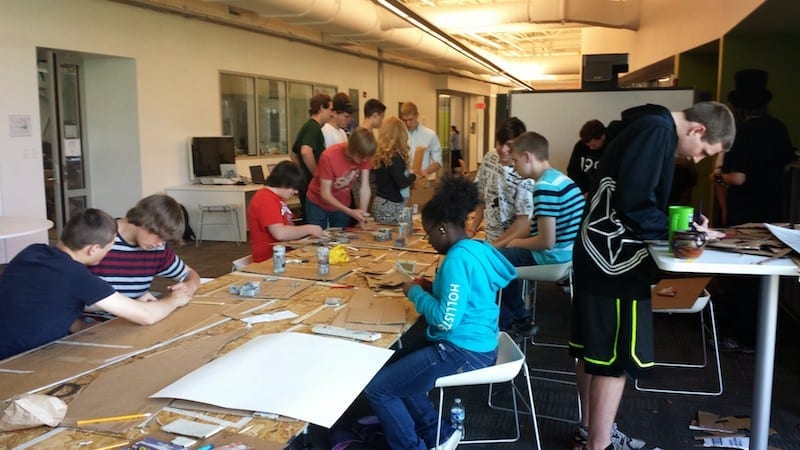Project-based learning (PBL) is a hot topic right now. It feels like the education pendulum is swinging back (finally!) from the extreme test prep brought on by No Child Left Behind. From the skills-based Next Generation Science Standards to the popularization of makerspaces, there are more and more initiatives that focus on students and learning. But is PBL just the latest education fad? Is it the next flavor of the month for professional development? I don’t think so.
PBL is not a new idea. John Dewey laid out the foundational ideas of PBL over one hundred years ago when he reported on the benefits of hands-on, experiential learning. Student-centered learning through PBL has been happening in pockets for decades. It is now finally getting mainstream attention. Here are seven reasons why high-quality PBL is not a fad, but a lasting framework that your school should adopt.
1. PBL creates student engagement.

The traditional style of lecturing, student note-taking, and regurgitating those notes on a test—rinse and repeat—is BORING. Surveys continue to show that many students are not engaged in school, with engagement decreasing as they get older. The research also shows that engaged students are the most successful ones. In PBL, students explore authentic problems in real contexts. The focus of the class shifts from the teacher being front and center to students actively learning together in groups. Active research and academic conversations, instead of passive listening, drive classroom time. Students explore relevant, personalized learning rather than an abstract, sterilized curriculum.
2. PBL teaches success skills.

We know the skills that students need to be successful in their careers and personal lives go beyond the curriculum. There is constant feedback from employers that students need more success skills, which include leadership, communication, collaboration, and time-management skills. In PBL, students are taught and assessed on these skills constantly. The skills are built into the project process. They are emphasized because the project work requires them. Students learn how to negotiate problems in their groups and communicate their solutions to a public audience. They gain confidence in themselves by developing these important life skills.
3. PBL helps students master the content knowledge.

While learning success skills is vital for students’ futures, we still have an obligation to teach them our required curriculum. A myth about project based learning is that it is light on content. Done correctly, PBL dives deeply into content through student inquiry. It connects standards to current issues in the community, making required content relevant. PBL challenges students to synthesize and apply their content knowledge to new situations. This leads to a depth of understanding that won’t be forgotten a week after the test.
4. PBL helps students engage in social-emotional learning.

It is no longer enough that a student makes strong academic progress in school. Educators have a duty to grow children holistically, and there has been an increased focus on mental health. Social-emotional learning (SEL) is a framework for meeting all of a students’ needs. SEL is a natural connection to PBL’s previously mentioned success skills. It allows educators to develop these skills in students in a way that is naturally part of the classroom routine. A key emphasis of a project-based-learning classroom is student voice and choice. PBL encourages students to become self-managers who are responsible and respectful of others in their groups. Learning to collaborate and work with others is a key aspect of social-emotional learning.
5. PBL promotes service learning.

We all want our students to grow up to be contributing members of the community. PBL is the perfect vehicle for a service-learning project, allowing students to make a difference. Students of all ages can work on a local issue, such as homelessness, clean water, or recycling. Too often we treat students like we are preparing them to do important work “someday.” Instead students should be doing meaningful work right now! And this does not just need to be in a service-learning class. Any PBL classroom can tie service learning into the content work.
6. PBL builds community connections.

A high-quality project based learning project requires a public product from students. Students create something throughout the course of the project to use or display publicly. This provides a great opportunity to strengthen ties between schools, parents, and the community at large by publicly showing important work that students are doing.
For example, students from Schoolcraft Elementary School helped a major farming operation choose the right potato to plant for the best yields. The students researched and studied the data to make their determination. In the end, they presented at a board meeting of farmers from across the Midwest and the East Coast, and the students’ recommendation was unanimously approved! Schoolcraft’s principal said that PBL projects are building up the school district’s reputation in the community. This, of course, leads to the support every school needs.
7. PBL creates lasting memories.

What do you remember about school? Chances are it is one or two teachers who really connected with you and some kind of meaningful project that you participated in. I can guarantee it wasn’t a worksheet or test-prep activity. PBL gives students the opportunity to complete meaningful work that they can be proud of for the rest of their lives. Students remember their favorite projects and are proud of them. Project based learning lets kids make a difference while learning the content and practicing success skills. PBL is not a fad. It’s a great framework where all kids will learn!
Join the great conversations going on about school leadership in our Facebook groups at Principal Life and High School Principal Life.
Plus, check out this article about giving teachers voice and choice.
